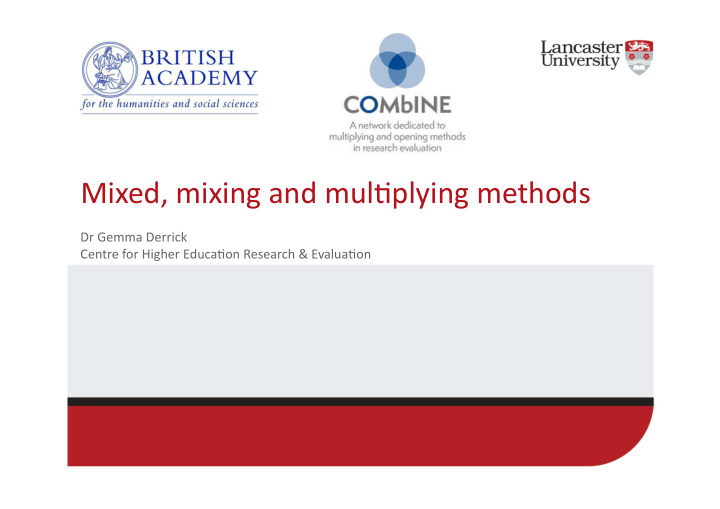



Mixed, mixing and mul.plying methods Dr Gemma Derrick Centre for Higher Educa.on Research & Evalua.on
Why mixed methods? “Methods should be mixed in a way that has complementary strengths and non-overlapping weaknesses. It involves the recogni=on that all methods have their limita=ons as well as their strengths” - Johnson and Turner (2003)
What is mixed-methods really? • U.lizing mul.ple methods (qual and quant) • Basic defini.on that it should combine two or more methods • Inten.onally integra.ng and combining these methods to draw on the strengths of each • Framing the inves.ga.on within mul.ple philosophical and/or theore.cal posi.ons. • Pragma.c methodology
Cri.cs (Creswell, 2007) Is there a post-posi.vist leaning to mixed methods? • Howe, K. R. (2004). A cri.que of experimentalism. Qualita=ve Inquiry, 10 , • 42-61. Giddings, L. S. (2006). Mixed-methods research: Posi.vism dressed in drag? • Journal of Research in Nursing, 11 (3), 195-2003. Holmes, C. A. (2007). Mixed(up) methods, methodology and interpre=ve • frameworks. Contributed paper for the Mixed Methods Conference, Cambridge, University, July 10-12, 2006. What are the limits for mixed methods research? • Sale, J. E. M., Lohfeld, L. H., Brazil, K. (2002). Revisi.ng the quan.ta.ve- • qualita.ve debate: Implica.ons for mixed-methods research. Quality and Quan=ty, 36, 43-53. Leahey, E. (2007). Convergence and confiden.ality? Limits to the • implementa.on of mixed methodology . Social Science Research, 36, 149-158. Is there a dominant discourse in mixed methods research? • • Freshwater, D. (2007). Reading mixed methods research: Contexts for cri.cism. Journal of Mixed Methods Research, 1 (2), 134-146.
Why mix? Validity Unexpected results • to corroborate quant and qual data • surprising results from one, other explains Offset Instrument development • offset weaknesses of quant and qual and to draw out strengths • qual employed to design instrument Completeness Credibility • more comprehensive account that • both approaches enhance integrity quant or qual alone of findings Process Context • quant provides outcomes, qual the • qual provides context; quant processes provides general Explana7on U7lity • qual can explain quant results or vice • more useful to prac..oners versa
Triangula.on • Denzin (1970) – Heavily influence by Wright Mills and the Chicago School of Urban Sociology. Reflexive and Interpre.ve • Date triangula.on: involves .me, space and people • Inves.gator triangula.on: involved mul.ple researchers in an inves.ga.on • Theory triangula.on: involved using more than one theore.cal scheme in the interpreta.on of the phenomenon • Methodological triangula.on: involved using more than one method to gather data, such as interviews, observa.ons, ques.onnaires and documents • “By combining mul=ple observers, theories, methods and empirical materials, researchers can hope to overcome the weakness or intrinsic biases and the problem that come from single method, single-observer and single-theory studies.”
Design considera.ons
How to mix? 1. Converge data QUAL RESULTS QUANT 2. Connect data QUAL QUANT RESULTS 3. Embed the data QUAL QUANT
What does MM mean for research evalua.on? • Move from logic-model of research produc.on and its evalua.on to a more democra.c model of co-produc.on and co-informa.on (realist evalua.on model) Point of evalua.on Process of knowledge produc.on Process of knowledge produc.on
The COMbINE Network The future of evalua7on is mixed ( hEp://combine.cwts.nl )
Recommend
More recommend